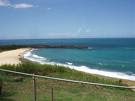
Since 1920, primary education has been free, compulsory, and nonsectarian. The adult illiteracy rate, estimated at 50% in 1920, stands at 4.3% in the year 2000, per UNESCO estimates (males, 4.1%; females, 4.5%). As of 1999, public expenditure on education was estimated at 3.7% of GDP.
Chile's present educational system stems from a 1965 reform program that called for curriculum modernization (with new texts for all grade levels), teacher training, and professional educational planning and management. There are both state-run and private schools; all state schools provide free education. An eight-year primary and four-year secondary program, with increased emphasis on vocational instruction at the secondary level, was introduced. Proposals are currently being considered to increase the amount of compulsory schooling from eight to ten years. In 1996, enrollment in primary schools totaled 2,241,536 students, taught by 73,960 teachers, with a student-to-teacher ratio of 30 to 1. Secondary schools had 739,316 students and approximately 52,000 teachers in the same year. The pupil-teacher ratio at the primary level was 33 to 1 in 1999. In the same year, 89% of primary-school-age children were enrolled in school, while 72% of those eligible attended secondary school.
The University of Chile (founded as Universidad Real de San Felipe in 1738) and the University of Santiago de Chile (founded as Universidad Técnica del Estado in 1949) are national universities with branches in other cities. There are numerous institutions which provide vocational and technical education. There are also several Roman Catholic universities. Higher educational enrollment was approximately 380,603 in 1997, compared with 145,497 in 1980.
Chile's present educational system stems from a 1965 reform program that called for curriculum modernization (with new texts for all grade levels), teacher training, and professional educational planning and management. There are both state-run and private schools; all state schools provide free education. An eight-year primary and four-year secondary program, with increased emphasis on vocational instruction at the secondary level, was introduced. Proposals are currently being considered to increase the amount of compulsory schooling from eight to ten years. In 1996, enrollment in primary schools totaled 2,241,536 students, taught by 73,960 teachers, with a student-to-teacher ratio of 30 to 1. Secondary schools had 739,316 students and approximately 52,000 teachers in the same year. The pupil-teacher ratio at the primary level was 33 to 1 in 1999. In the same year, 89% of primary-school-age children were enrolled in school, while 72% of those eligible attended secondary school.
The University of Chile (founded as Universidad Real de San Felipe in 1738) and the University of Santiago de Chile (founded as Universidad Técnica del Estado in 1949) are national universities with branches in other cities. There are numerous institutions which provide vocational and technical education. There are also several Roman Catholic universities. Higher educational enrollment was approximately 380,603 in 1997, compared with 145,497 in 1980.


No hay comentarios:
Publicar un comentario